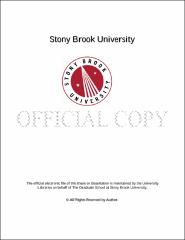| dc.identifier.uri | http://hdl.handle.net/11401/76544 | |
| dc.description.sponsorship | This work is sponsored by the Stony Brook University Graduate School in compliance with the requirements for completion of degree. | en_US |
| dc.format | Monograph | |
| dc.format.medium | Electronic Resource | en_US |
| dc.language.iso | en_US | |
| dc.publisher | The Graduate School, Stony Brook University: Stony Brook, NY. | |
| dc.type | Dissertation | |
| dcterms.abstract | Signal Transducer and Activator of Transcription 5 (STAT5) is a transcription factor that is critical for various biological processes including hematopoiesis, liver metabolism and mammary gland development. However, persistent activation of STAT5 has been causally linked to human leukemia and solid tumor formation. Since STAT5 is important for normal physiological functions and aberrant activity can promote cancer, accurate regulation of STAT5 is essential. As a transcription factor, STAT5 must gain entry into the nucleus to act, and one means of controlling its activity is to regulate its cellular localization. This study explores the nuclear trafficking mechanisms of STAT5a that may provide information to stimulate or inhibit its actions. Classically, proteins that are actively transported through nuclear pore complexes in the nuclear membrane have a short stretch of basic amino acids called the nuclear localization signal (NLS). The classic NLS can be recognized by transport receptor called importins that mediate nuclear import. In this study we provide evidence that STAT5a has an unconventional large NLS that functions within the conformation of a coiled-coil domain. With the use of both in vitro binding and in vivo functional assays, we demonstrate that STAT5a nuclear import is mediated by the importin-a3/b1 system. The integrity of the STAT5a NLS is required for the transcription of b-casein milk protein gene in response to prolactin, and the ability of STAT5a to synergize with the glucocorticoid receptor. The glucocorticoid receptor localizes to the nucleus following prolactin treatment, and this nuclear accumulation is dependent on STAT5a nuclear import. STAT5a continuously shuttles between nucleus and cytoplasm independent of tyrosine phosphorylation, and live cell imaging with photobleaching assays reveal that STAT5a nuclear export is mediated by both the conventional Crm1 exportin and by a Crml-independent pathway. A Crm1-dependent nuclear export signal (NES) was identified in the STAT5a amino-terminal domain, and a Crm1-independent NES in the DNA-binding domain of STAT5a. These findings provide insight to fundamental mechanisms of STAT5a nuclear trafficking and cooperation with glucocorticoid receptor, and provide a basis to design clinical therapeutics to target STAT5a activity in human disease. | |
| dcterms.available | 2017-09-20T16:50:36Z | |
| dcterms.contributor | Marshall, Nancy Reich | en_US |
| dcterms.contributor | Hearing, Patrick | en_US |
| dcterms.contributor | Hayman, Michael | en_US |
| dcterms.contributor | Krug, Laurie | en_US |
| dcterms.contributor | Thomsen, Gerald. | en_US |
| dcterms.creator | Shin, Ha Youn | |
| dcterms.dateAccepted | 2017-09-20T16:50:36Z | |
| dcterms.dateSubmitted | 2017-09-20T16:50:36Z | |
| dcterms.description | Department of Molecular Genetics and Microbiology. | en_US |
| dcterms.extent | 117 pg. | en_US |
| dcterms.format | Monograph | |
| dcterms.format | Application/PDF | en_US |
| dcterms.identifier | http://hdl.handle.net/11401/76544 | |
| dcterms.issued | 2013-12-01 | |
| dcterms.language | en_US | |
| dcterms.provenance | Made available in DSpace on 2017-09-20T16:50:36Z (GMT). No. of bitstreams: 1
Shin_grad.sunysb_0771E_11460.pdf: 3677160 bytes, checksum: 8596741e35ae9c30186250acaff19367 (MD5)
Previous issue date: 1 | en |
| dcterms.publisher | The Graduate School, Stony Brook University: Stony Brook, NY. | |
| dcterms.subject | Cellular biology | |
| dcterms.subject | Nuclear Trafficking, STAT5 | |
| dcterms.title | Doctor of philosophy | |
| dcterms.type | Dissertation | |

